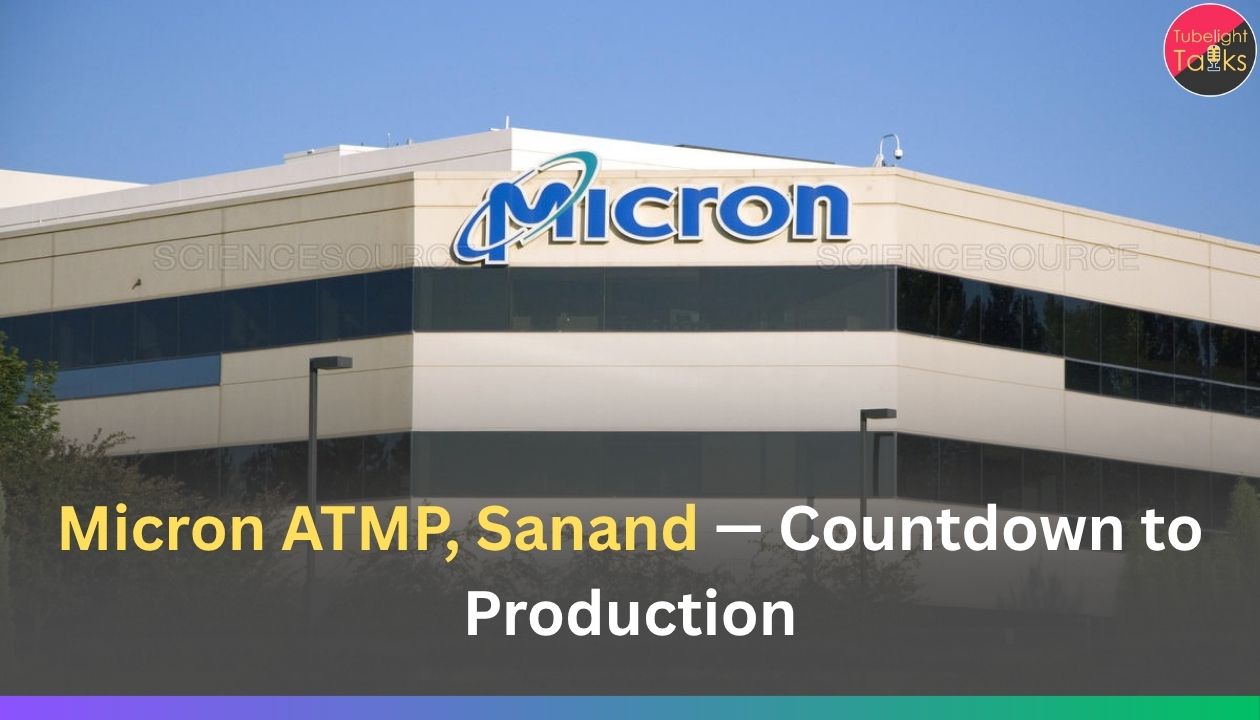Micron ATMP: Indian business dailies and trade outlets reported in late June 2025 that Micron’s Sanand ATMP (assembly, testing, marking, packaging) facility entered the cleanroom validation stage—essential before bringing in tools and live product.
Start of output: late 2025 to early 2026 (indicative): Micron’s original guidance (June 2023) said Phase-1 would “start to become operational in late 2024”—that’s slipped, but local updates now peg initial output in Dec 2025–Jan 2026. A Nov 2025 ministerial review in Gujarat highlighted steady progress.
Investment & support: Project outlay ₹22,516 crore (~$2.75B) with 50% central fiscal support (pari passu); state incentives under the Gujarat policy apply. Jobs: up to 5,000 direct and 15,000 indirect over five years.
Where the build stands (Phase-1)
- Scale: Phase-1 includes ~500,000 sq ft of planned cleanroom; Phase-2 of similar scale is slated for the second half of the decade.
- Construction & fit-out: With cleanroom validation in motion, next steps are tool move-in, qualification lots, and line ramp. (EPC contractors and local press also point to year-end construction close, aligning with the production window.)
- Government oversight: The Nov 2025 review in Gandhinagar covered utilities (power, water), logistics, and vendor-park readiness around Sanand/Dholera.
Jobs and skills: what to expect
- Headcount path: The 5,000 direct jobs are spread across operators/technicians, process & test engineers, quality, maintenance, EHS, and supply-chain roles; 15,000 indirect include logistics, campus services, and supplier MSMEs. (PIB baseline.)
- Shift model: ATMP plants run 24×7 in shifts; local ITIs and polytechnics around Ahmedabad/Sanand are scaling soldering/AOI/metrology skills. (Captured in state/central reviews.)
What Sanand will actually do (and won’t)
- Will do: Back-end work—dice, assemble (wire-bond/flip-chip), mold, mark, test, and package memory products from incoming wafers/dies.
- Won’t (yet): Front-end wafer fabrication. India still imports wafers/dies, so the plant depends on global front-end fabs for feedstock. That’s typical for first-wave projects focused on OSAT/ATMP.
India’s chip value-chain gaps (and why they matter)
- Front-end wafers: No leading-edge fabs yet; even mature-node capacity is nascent, so dies arrive from abroad. That adds supply risk and logistics costs. (Policy briefings stress the step-by-step path: design → ATMP → mature fabs.)
- Substrates & leadframes: ABF substrates (Ajinomoto build-up film) and high-reliability leadframes are mostly imported; local investments are still at MoU/early-line stage. (State/industry notes.)
- Specialty gases/chemicals: Even ATMP needs ultra-pure N₂, CDA, forming gases, solvents, mold compounds—most are imported or blended locally with imported precursors.
- Tools & spares: Dicing, wire bonders, testers, handlers, molding presses remain import-heavy; India must deepen field-service and spares presence to reduce downtime.
Why this plant still moves the needle
- Exports & reliability: Back-end is where yield, test coverage, and traceability get locked. A high-volume ATMP boosts India’s electronics exports and builds supplier confidence for the next rung (advanced packaging, mature fabs).
- Cluster effect: Sanand’s supplier parks + Dholera infra build-out (power/water/logistics) create co-location economics for EMS, substrate makers, gases, and packaging materials.
What to watch next
- Tool move-in & qualification lots after cleanroom validation.
- Hiring spikes for operators/technicians (job boards, ITI linkages).
- Utilities & permits: stable power, ultra-pure water, waste handling sign-offs (state updates).
- Supplier announcements for substrates, gases, mold compounds near Sanand/Dholera.
Build Fast, Guard Dignity
Ramping a 24×7 plant tests more than engineering—it tests conscience. A simple ethic of truthfulness, non-harm, service, and restraint highlighted in Sant Rampal Ji Maharaj spiritual discourse turns speed into safe speed: transparent incident reporting, real safety (not paper), respectful shifts and dorm standards, and equal-opportunity hiring. That’s how a flagship factory becomes a human-centred success, not just a headline.
Sources
- Micron: India ATMP announcement—Phase-1 late-2024 ops, 500,000 sq ft cleanroom, phased expansion.
- Economic Times / Outlook Business: Cleanroom validation underway at Sanand (June 25, 2025).
- PIB: Investment ₹22,516 crore, 50% central support, 5,000 direct + 15,000 indirect jobs.
- Govt/press review: Nov 2025 progress review (utilities, vendor parks) in Gujarat.
- Local update: Initial output Dec ’25–Jan ’26 (Sanand press).
FAQs: Micron ATMP, Sanand
1) When will production start?
Cleanroom validation is underway; first output is indicatively targeted for Dec 2025–Jan 2026, pending tool install and qual lots.
2) How many jobs will it create?
About 5,000 direct roles (operators, process/test, quality, maintenance, EHS, supply chain) and ~15,000 indirect over five years.
3) What does an ATMP plant do (and not do)?
It handles Assembly, Testing, Marking, Packaging of memory chips from imported dies/wafers; it does not fabricate wafers (no front-end fab).
4) What are the key value-chain gaps today?
India still imports dies/wafers, ABF substrates/leadframes, specialty gases/chemicals, and many tools/spares—localisation is early-stage.
5) Why does this project matter?
High-volume ATMP boosts electronics exports, builds supplier confidence, and lays the groundwork for advanced packaging/mature-node fabs in India.










